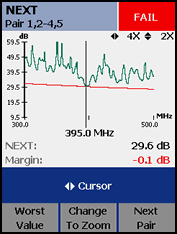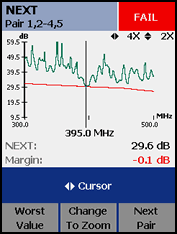12 dB-Regel - DTX CableAnalyzer
In the DSX-5000 CableAnalyzer, this is implemented automatically.
If you test to either "ISO11801 Class Ea Channel" or "ISO11801 Class PL2 Class Ea" and the insertion loss measurement is less than 12 dB at 450 MHz, a relaxed NEXT limit may be applied. It is not possible to change PASS/FAIL limits in a field tester based on the measured result of a parameter. Compliance with ISO/IEC 11801 Class EA requirements can be verified using the DTX CableAnalyzer in one of two ways:
- by obtaining a PASS condition using the regular "ISO11801 Channel Class Ea" or "ISO11801 PL2 Class Ea" test option, or
- by obtaining a PASS condition using an alternate "ISO11801 Chan Class Ea Low IL" or "ISO11801 PL2 Class Ea Low IL" option; if a PASS* conditions applies to insertion loss, the true result should be a PASS, as explained in the following.
ISO/IEC 11802:2002 Amendment 2 (Published April 2010) - Table A.5
"For Configurations PL1, PL2, and CP1, whenever the class EA permanent link insertion loss at 450 MHz is less than 12 dB, subtract the term 1,4((f - 450)/50) to the equation stated above for the range of 450 MHz to 500 MHz."
ANSI/TIA-568-C.2 (Published August 2009)
There is no such rule/requirement in this North American Standard for Category 6A.
Reality check
It is very unlikely that implementing the "12 dB rule" is going to turn your failing NEXT and PS NEXT results into a PASS. That's because the NEXT limit is relaxed between 450 MHz and 500 MHz only, and not by much. Let's take an example:
| Tested to "ISO11801 PL2 Class Ea" | Tested to "ISO11801 PL2 Class Ea Low IL" | ||
|
|
It did not change the outcome of the test result, because the failing NEXT was not between 450 MHz and 500 MHz. This may be better explained using an animation:
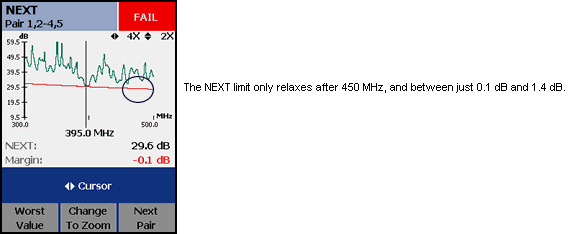
Known issue in previous DTX code
The "ISO ClassEa Ch AMD1 Low IL" and "ISO ClassEa PL2 25N1599 Lo IL" test options in the DTX had an insertion loss limit of 12 dB at 450 MHz to prevent the user from incorrectly applying the “12 dB rule” detailed previously. The DTX CableAnalyzer (Version 1,36 limits) had an insertion loss limit that has a step response at 450 MHz as indicated below:
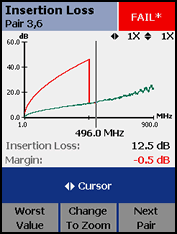
This could result in a measurement incorrectly assigning a FAIL for the insertion loss parameter. It’s incorrect because the existing limit for insertion loss still applies; the 12 dB is only used for assessing whether the relaxed NEXT limit should be applied. As a result, we have changed the limit for insertion loss in the DTX CableAnalyzer and LinkWare software. The above result will now look like:
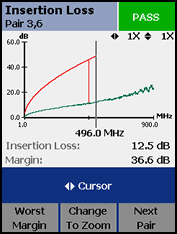
The change indicated was incorporated into the DTX CableAnalyzer Software Version 2,22 and LinkWare 6,0 releases.
If the AUTOTEST fails now, it’s because it failed to meet the 12 dB insertion loss requirement at 450 MHz, indicating that this test option cannot be used to achieve a PASS result for the Class EA channel.
It is possible for the DTX CableAnalyzer to report a PASS* for insertion loss @ 450 MHz if the measured insertion loss at 450 MHz is closer to 12 dB than the specified accuracy of the DTX CableAnalyzer. This PASS* for insertion loss indicates that the DTX CableAnalyzer cannot determine within its measurement accuracy whether the relaxed NEXT and PS NEXT limits are applicable. It does not necessarily indicate that the measured insertion loss is within the measurement uncertainty of the limits for insertion loss that is applicable to ISO/IEC 11801 Class EA cabling. If necessary, the true insertion loss performance of the cabling can be verified using the regular "ISO11801 Channel Class Ea" and "ISO11801 PL2 ClassEa" test options, and observing the test result for insertion loss. If this result does not contain a PASS* result for insertion loss, the PASS* for insertion loss of the ISO11801 Chan ClassEa Low IL test, technically speaking, should be a PASS and not PASS*. This is a limitation of the code in the DTX CableAnalyzer.
In conclusion:
The overall result of an ISO/IEC 11801 Class EA test should be as follows:
- If either the "ISO11801Channel Class Ea" or "ISO11801Chan Class Ea Low IL" test shows a pass, the result is a PASS.
- If either the "ISO11801 PL2 ClassEa" or "ISO11801 PL2 ClassEa Low IL" test shows a pass, the result is a PASS.
- If the "ISO11801Chan Class Ea Low IL" or "ISO11801 PL2 ClassEa Low IL" test shows a PASS* that is caused by the result for insertion loss only, the result of the "ISO11801Chan Class Ea Low IL" or "ISO11801 PL2 ClassEa Low IL" should be reviewed for insertion loss only; if this result is a PASS, the result of the "ISO11801Chan Class Ea Low IL" or "ISO11801 PL2 ClassEa Low IL" test can be considered to be PASS (the ‘*” is not applicable).

